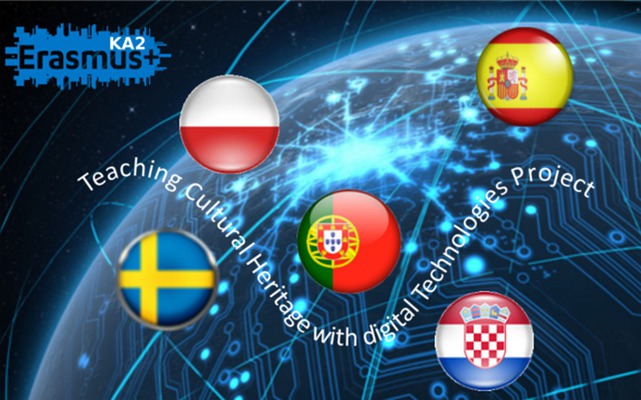Nawigacja
- INFORMACJE DLA PRACOWNIKÓW
- Strona główna
- Wszystkie wiadomości
- Kontakt
- REKRUTACJA 2021/2022
- EGZAMIN ÓSMOKLASISTY
- Polonistyczne Pogotowie Egzaminacyjne
- O szkole
- Rada Pedagogiczna
- Szkolna Rada Rodziców
- Procedury postępowania w sytuacjach kryzysowych z udziałem uczniów
- Regulaminy szkolne
- Ważne dokumenty
- Imprezy szkolne 2020/2021
- Drzwi otwarte szkoły
- Samorząd Uczniowski
- Olimpiady i konkursy przedmiotowe
- Harmonogram pracy pedagogów i psychologów
- Gazetka szkolna
- Biblioteka
- Obiekty sportowe
- Projekty UE
- PRZEDSZKOLE
- Nasze stare strony www
- Ochrona Danych Osobowych
- SZKOŁA PAMIĘTA 2019\2020
Erasmus+ Teaching Cultural Heritage
Projekt Erasmus+ Nauczanie Dziedzictwa Kulturowego z Wykorzystaniem Technologii Cyfrowych
1) Krótkoterminowa wymiana uczniów w szkole z Chorwacji
Metoda realizacji: wycieczki, pokaz, zajęcia w grupie, webquest, korzystanie z narzędzi ICT
Rezultaty: poszerzenie wiedzy nt. dziedzictwa kulturowego Hiszpanii, Portugalii, Szwecji i Chorwacji, korzystanie z nowoczesnych technologii, nagranie filmu o Chorwackiej kulturze.
W dniach 1-5 października sześcioro uczniów Szkoły Podstawowej nr 5 i 2 nauczycieli wzięło udział w krótkoterminowej wymianie młodzieży w Chorwacji w ramach projektu Erasmus+ "Teaching Cultural Heritage with Digital Technologies". Wspólnie ze swoimi rówieśnikami z Hiszpanii, Portugalii, Szwecji i Chorwacji rozwijali swoje kompetencje językowe i cyfrowe oraz poszerzali swoją wiedzę na temat dziedzictwa kulturowego.
Projekt wymiany powstał ze względu na Europejski Rok Dziedzictwa Kulturowego 2018: Angażowanie młodzieży w integracyjną i zrównoważoną Europę (2018 European Year of Cultural Heritage: Engaging Youth for an Inclusive and Sustainable Europe).
2) Konkurs na Logo projektu

3) Przeprowadzenie lekcji związanej z dziedzictwem kulturowym poszczególnych regionów w Polsce z wykorzystaniem narzędzi ICT na lekcji matematyki, zorganizowanie wystawy w języku angielskim.
4) Scenariusz lekcji
The author: Aneta Seremak
School subject taught: Mathematics
Selected ICH element: Regional patterns from different parts of Poland (Kaszuby, Lowicz, Podhale, Lubelszczyzna)
How did ICH contribute to school learning: students get to know where are regions Kaszuby, Lowicz, Podhale, Lubelszczyzna on the Polish map, they are able to work in groups, they know how to find information in the Internet, students are able to identify symmetrical figures, draw lines of symmetry and explain why or why not a figure has symmetry, students are more aware about ICH (awarness raising), students get to know or understand better the family rituals and traditions (transmission of ICH knowledge which is present in student‘s families and local community), students are able to identify from which region a certain pattern comes from.
The classes where very interesting for students because of ICH elements, they were inspired, interested in the topic, enthusiastic and involved.
Main topics of the lesson Mathematics (symmetry, the axis of symmetry, symmetrical figures), regions in Poland (Kaszuby, Lowicz, Podhale, Lubelszczyzna).
Learning objectives:
- students will be able to identify symmetrical figures, draw lines of symmetry and explain why or why not a figure has symmetry
- students will be more aware about ICH (awarness raising)
- students will get to know or understand better the family rituals and traditions (transmission of ICH knowledge which is present in student‘s families and local community)
-students will be able to identify from which region a certain pattern comes from
Activities and content developed to reach the learning objectives.
I. Teacher divides students into 4 groups and gives them the homework. Every group has to do the research on the Internet about traditional patterns from the different parts of Poland (Kaszuby, Lowicz, Lubelszyczyzna, Podhale). Students should be able to answer the questions:
-What kind of patterns come from the particular region?
-What kind of things, plants, colours are on this patterns?
Students are asked to bring the picture/drawintg of the pattern.
II. Checking the homework, every group presents their outcome, shows on the map of Poland from which region the patterns come from.
III. Teacher introduces the concept of symmetry, lines of symmetry, symmetrical figures.
IV. Students are asked to do exercises (working on patterns they have brought and teacher´s copies).
1. Give the example of shapes with no line of symmetry/with line/lines of symmetry.
2. State the number of lines of symmetry for the given patterns.
3. Draw the lines of symmetry for the given patterns.
4. Given the line of symmetry complete the pattern performing reflection in the dotted (mirror line).
5. Find the geometrical figures in the given patterns and name them in English. Write the formulas for their areas.
V. HOMEWORK:
Teacher asks students to:
Find if in their families there is a traditional object with a spacific pattern and learn about it as much as they can (what was it used for, how long it is in the family).
Record a short film/poster/presentation about this object. If there is not any traditional object in your family inspired by examples from the classes design and draw your own pattern.
RESOURCES:
-the internet
-families stories
-optional: a guest from a local folk group Leszczyniacy.
EVALUATION:
Math test
Discussion (What did you learn? Did you get something new about your family traditions?)
THE OUTCOME
An exhibition of student‘s work at school
Kontakt
-
Szkoła Podstawowa nr 5 im. Janusza Kusocińskiego w Świdniku
21-040 Świdnik ul. Jarzębinowa 6 - 81 751-33-71